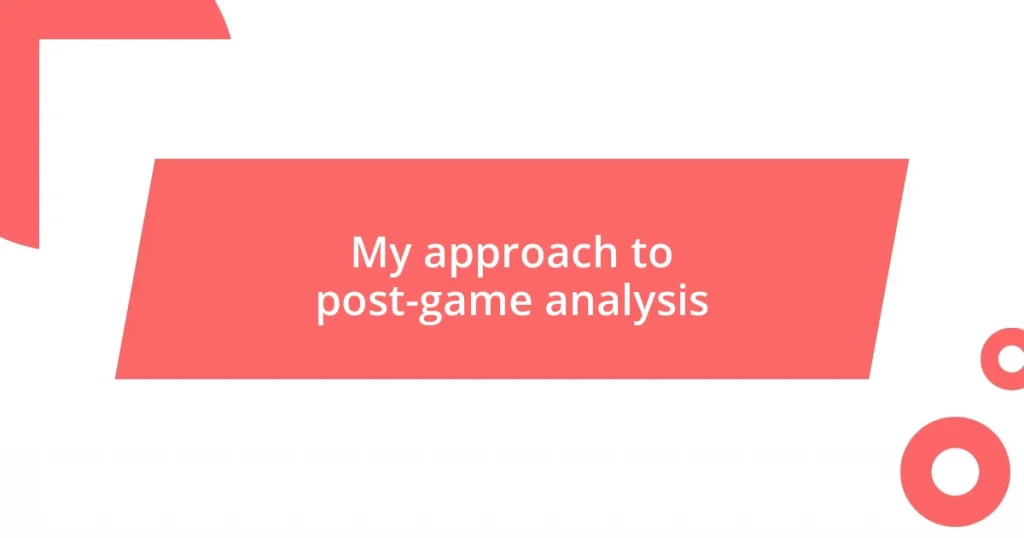Key takeaways:
- Post-game analysis is vital for understanding performance, fostering team cohesion, and creating a culture of continuous improvement.
- Key components of analysis include evaluating key plays, player performance, tactical strategies, and team dynamics to enhance future gameplay.
- Implementing actionable improvement plans, accountability, and integrating feedback are essential for personal and team growth on the field.

Introduction to post-game analysis
Post-game analysis is not just about reviewing what happened on the field; it’s an essential process that allows players and coaches to truly understand their performance. Reflecting on matches can stir up a whirlwind of emotions for me—it’s that blend of excitement and frustration that drives improvement. Have you ever rewatched a game and felt that rush of memories, reliving those critical moments?
When I first started diving into post-game analysis, I remember feeling overwhelmed by the sheer amount of detail to consider. I learned to break it down: focus on key plays, assess player interactions, and evaluate overall strategies. It was during these moments of quiet reflection that I realized the power of insightful questions. For example, asking myself, “What could I have done differently?” not only helps identify areas for growth but also fosters a supportive environment for my teammates.
As I analyze each game, it’s like piecing together a puzzle where every loss or win contributes to our overall development. Each analysis session is a chance to learn, not just about the sport, but about resilience and teamwork. How can we transform our experiences into stepping stones, rather than stumbling blocks? It’s this journey through the ups and downs that truly shapes our understanding of the game and ourselves.
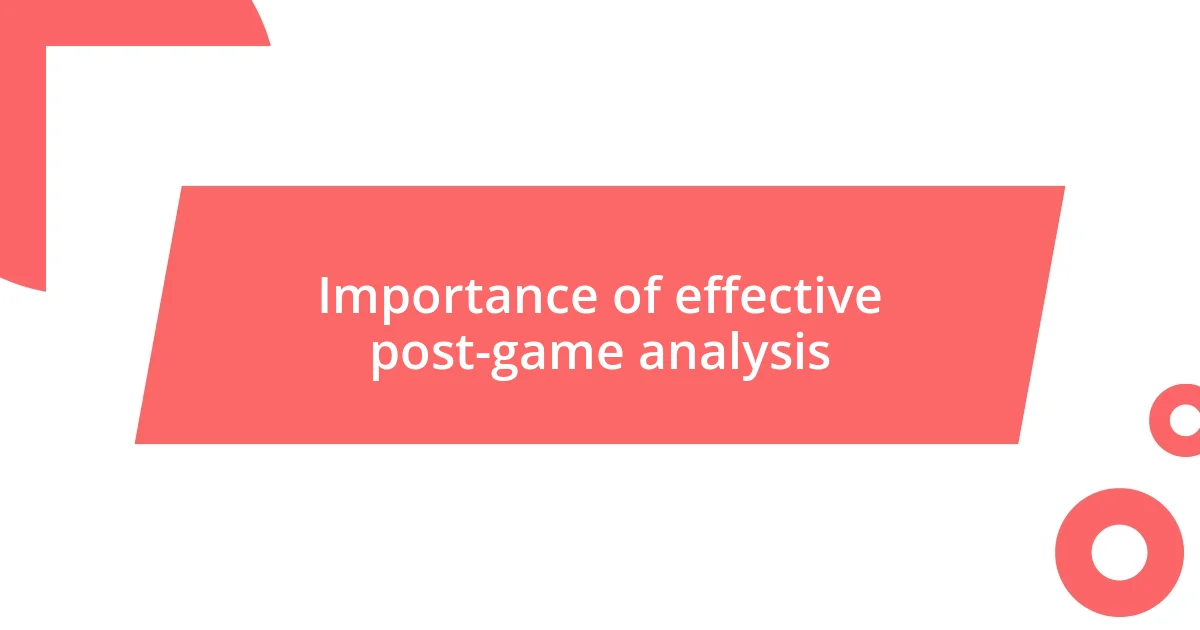
Importance of effective post-game analysis
Effective post-game analysis serves as the cornerstone for continuous improvement in any sport. It’s not merely an exercise in identifying mistakes; it’s about celebrating successes and learning from missteps. I vividly recall a turning point after a particularly close loss, where dissecting our performance revealed both our strengths and weaknesses. That clarity transformed our approach in future games, making us more cohesive as a team.
The emotional journey during these analysis sessions can be quite profound. For me, the thrill of breaking down a brilliant play ignites a sense of pride, while reflecting on errors can be humbling. It’s crucial to maintain a balance between acknowledging what went right and what needs work. Have you ever felt that mix of hope and dread when revisiting a game? This duality often fuels our motivation; it’s that intrinsic drive to be better that keeps me engaged.
In summary, the significance of post-game analysis is complemented by the relationships it fosters within a team. I’ve witnessed how open discussions about our performances strengthen bonds and cultivate trust. It’s these shared experiences—tailored insights into one another’s play—that foster a culture of improvement and unity, making the team more resilient as we strive for excellence together.
| Aspect | Importance |
|---|---|
| Understanding Performance | Helps identify strengths and areas for improvement. |
| Team Cohesion | Fosters trust and collaborative growth among team members. |
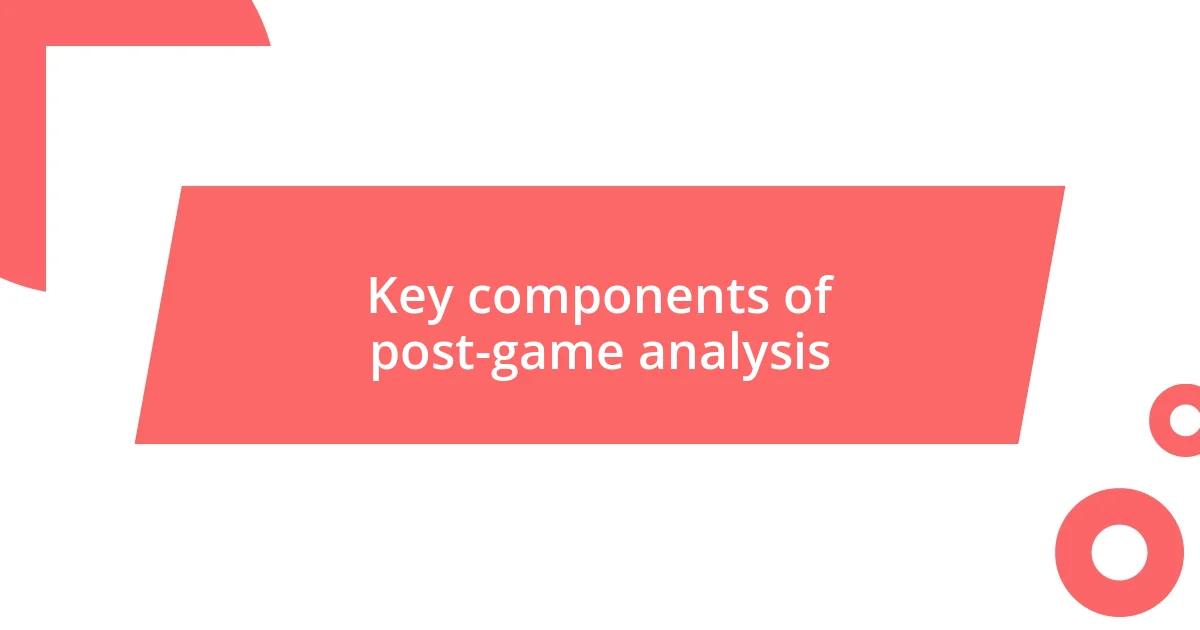
Key components of post-game analysis
Post-game analysis distills the chaos of a match into clear, actionable insights. In my experience, focusing on specific components not only sharpens our understanding but also paves the way for strategic adjustments. Each segment of the game, from individual plays to overall tactics, contributes uniquely to the big picture. I remember a game where we lost track of positioning; revisiting those moments during analysis revealed patterns we could address.
Here are the key components I prioritize during my analysis:
- Key Plays: Identifying pivotal moments that shifted the game’s momentum, helps us understand decision-making processes.
- Player Performance: Evaluating individual contributions aids in recognizing strengths and areas for improvement.
- Tactical Review: Analyzing strategies employed during the match allows for refinement and better preparation for future games.
- Emotional Reflection: Taking time to process feelings about the game helps everyone align their mental state for growth.
- Team Dynamics: Observing how we interacted helps in fostering a supportive environment where open communication thrives.
This multifaceted approach allows for a deeper understanding of each player’s role within the greater framework of team success. Reflecting on these components isn’t always easy, but I’ve found that embracing vulnerability during discussions fosters a stronger connection among teammates. The lightbulb moments we share during these analyses often turn into the building blocks for what we can achieve next.

Techniques for gathering game data
Gathering game data is crucial, and I’ve found a variety of techniques that really enhance this process. One effective method is the use of video analysis. I recall a season where we recorded every game and reviewed the footage together as a team. Watching those tangible moments unfold—seeing both the slick passes and the defensive errors—opened my eyes to aspects of our play I hadn’t recognized during the heat of the match.
Another approach I rely on is statistical analysis. Utilizing software and apps that track player performance metrics, such as passing accuracy and shot placement, has been a game changer. After one particular match, diving into the data revealed that our shooting percentage was concerningly low. This realization prompted focused shooting drills in practice, which significantly improved our confidence as we approached the next game.
Finally, I also emphasize the importance of player feedback. After every match, I encourage teammates to share their thoughts and observations in a casual setting. It’s amazing what you learn from simply asking, “What did you feel out there?” This practice not only garners diverse perspectives but also fosters a supportive atmosphere where everyone feels valued. Isn’t it fascinating how a simple conversation can yield insights that stats and videos sometimes overlook?
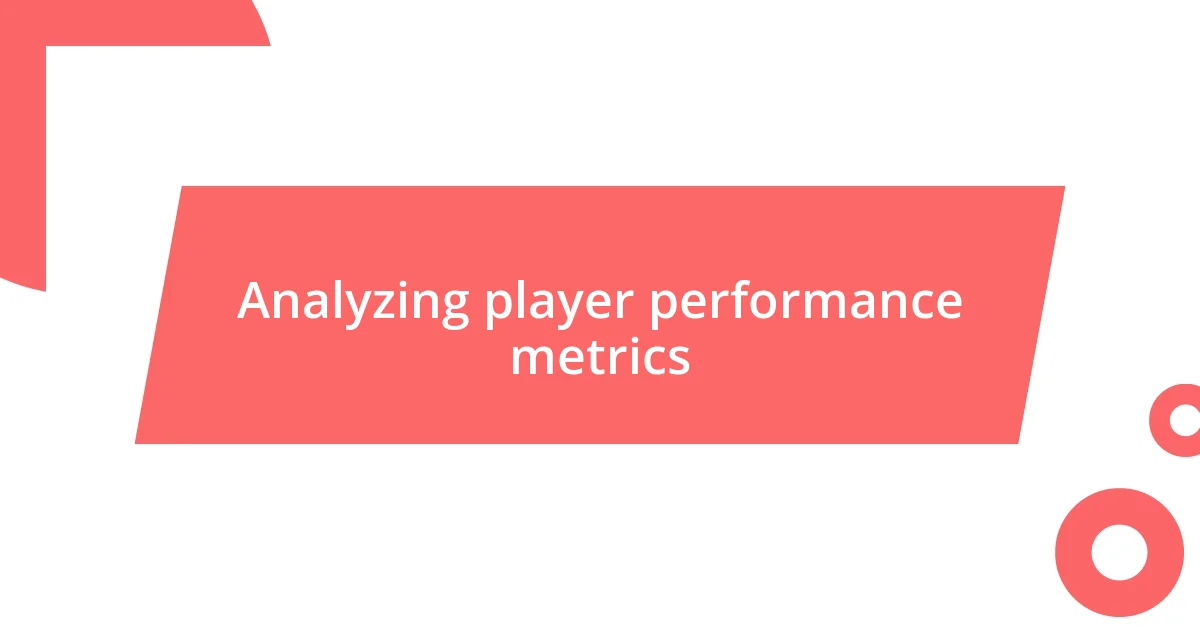
Analyzing player performance metrics
When I analyze player performance metrics, I always start by looking at the numbers, but I don’t stop there. For instance, during one match, my teammate John consistently received passes but struggled to make impactful plays. When I looked at the data, it showed his passing percentage was high but his assists were low. This stark contrast made me question what was happening on the field. Often, it’s the small decisions that speak volumes about a player’s influence in the game.
Delving deeper into individual metrics reveals hidden stories. I remember a game where our forward, Sarah, displayed impeccable sprint speed yet seemed to fade during critical moments. It was only when I studied her distance covered that the connection became clear: she was exhaustively chasing down every lost opportunity. This led me to realize that while her effort was commendable, there needed to be a strategic rest period to maximize her effectiveness during high-stakes plays. Have you ever noticed how understanding a player’s endurance can completely shift how you strategize their usage during a game?
Ultimately, I find that player performance metrics can catalyze pivotal conversations in the team. After one particular match, my observation of the defensive stats opened the door for a team meeting. We discovered that while one player was excellent at initiating tackles, they often risked being out of position. Engaging in an open dialogue about what those metrics meant helped us realign our defensive strategies. Isn’t it empowering to see how metrics can not only inform decisions but also unite a team in pursuit of a common goal?

Creating actionable improvement plans
Creating actionable improvement plans is not just about identifying problems; it’s about forging pathways to success. In one instance, after a lackluster performance, I gathered my teammates and we discussed specific adjustments we could make. By setting individual goals, like increasing defensive awareness or improving communication, everyone left the meeting with clarity and purpose. Doesn’t it feel good to know that each person has a clear direction?
When designing these improvement plans, I always incorporate short-term and long-term goals. For example, after a particularly tough loss, I suggested we focus on our ball possession in the next few games. First, we zeroed in on retaining the ball during practice sessions, then we aimed to sustain that possession during actual matches. This allowed us to see incremental progress, building our confidence in tandem. Have you ever noticed how small victories can lead to larger ones on the field?
A crucial part of this process is accountability. I remember a time when we set up buddy systems, pairing players to encourage each other’s growth. It was heartening to see teammates pushing one another to hit their targets and share insights. This dynamic not only made our practices more focused but also strengthened camaraderie within the team. How often do you find that personal relationships fuel professional growth? In my experience, it’s a match made in heaven.
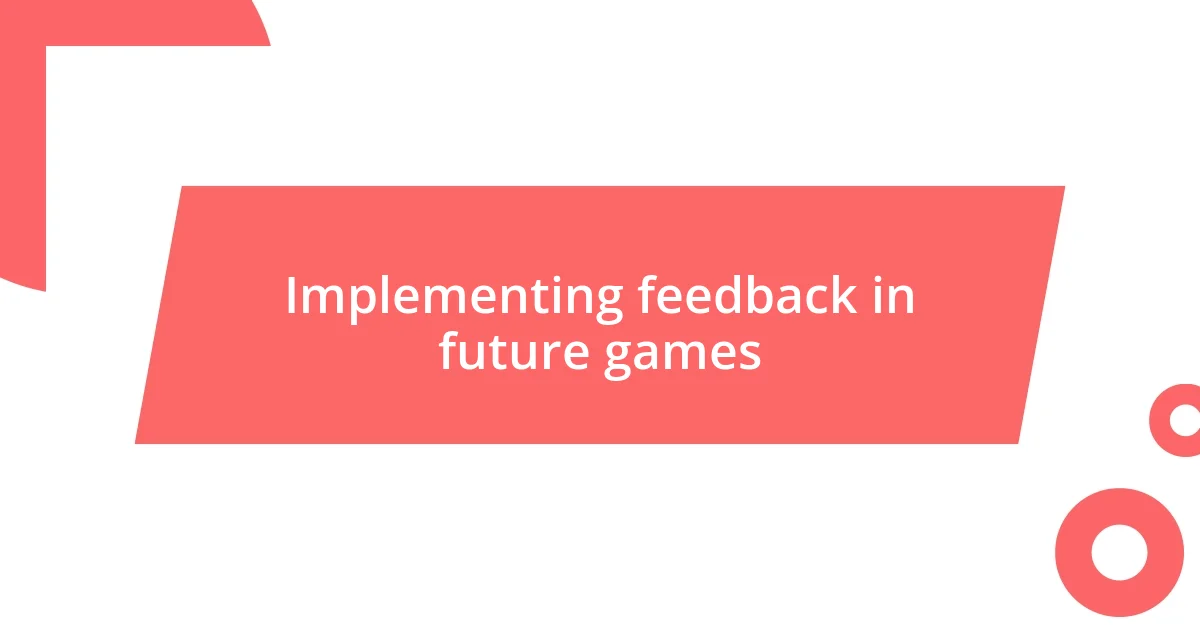
Implementing feedback in future games
Understanding feedback is crucial when we look towards future games. I vividly recall a game where my passing accuracy seemed fine, but after reviewing feedback, I realized my decision-making was subpar. I started to incorporate a habit of visualizing multiple options before receiving the ball; this adjustment significantly improved my gameplay in subsequent matches. Have you ever made a single tweak that changed your entire perspective on the field?
When it comes to integrating feedback, I believe in the power of mindfulness during practice. For example, after receiving feedback about my defensive positioning, I decided to focus on being more aware of my surroundings. I started playing practice matches with a specific mindset, always asking myself, “What would be the best angle to intercept?” In the following games, I noticed I was not just reacting but anticipating plays, leading to a more proactive defensive style. Isn’t it interesting how a simple shift in mindset can open up a world of possibilities?
Another key to implementing feedback lies in collaborative learning. I initiated post-practice discussions with fellow players, where we shared what we learned from the feedback we received. This not only allowed us to tackle issues together but also created an environment of continuous improvement. I still remember the lightbulb moments when a teammate suggested viewing how different formations affected our play. Who would have thought that collective insights could accelerate our growth so much?










